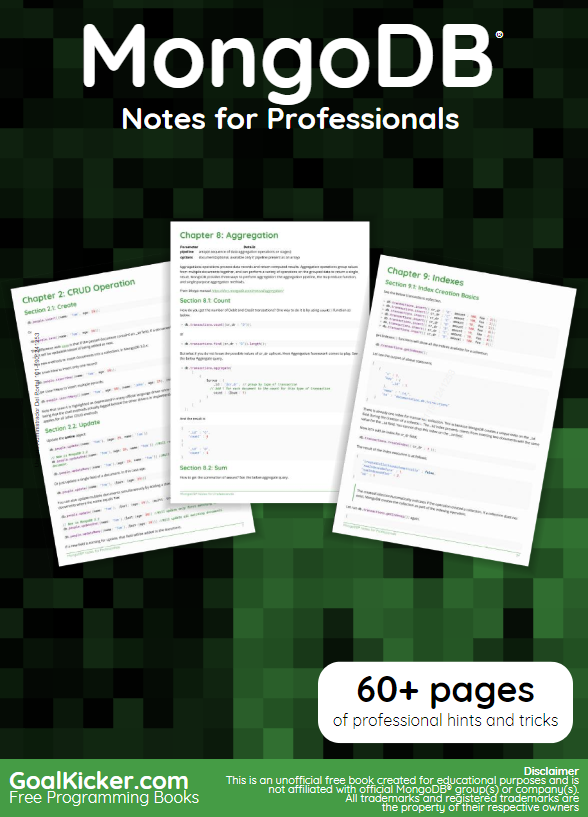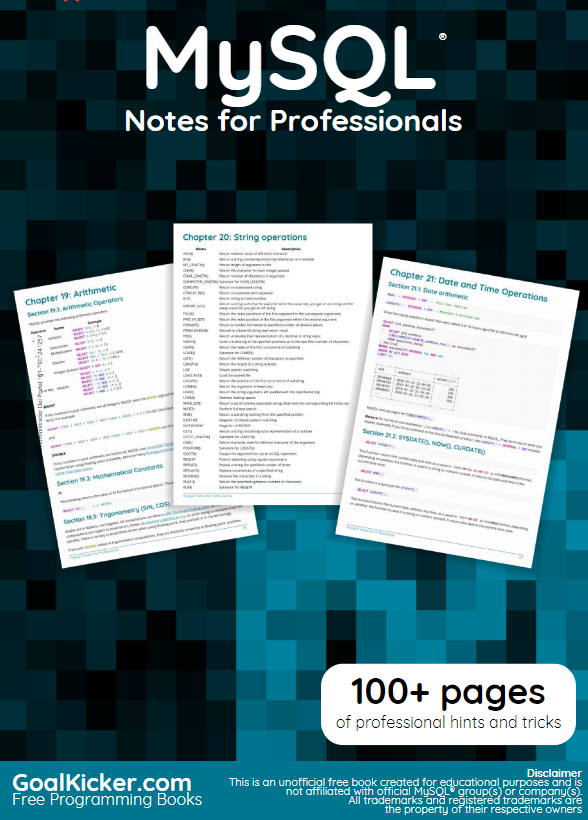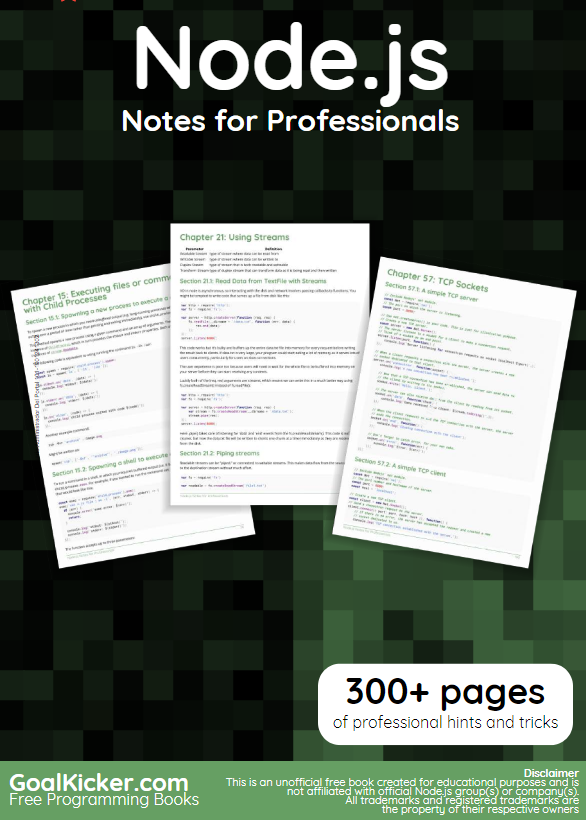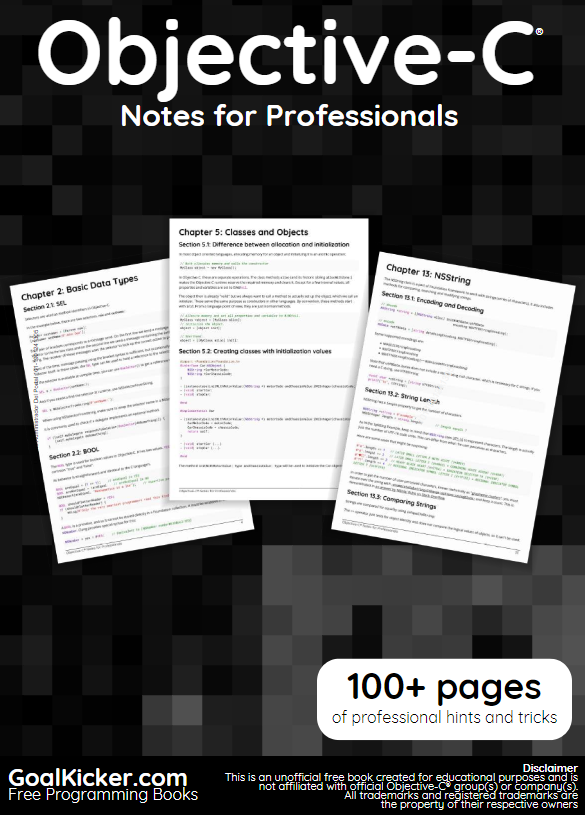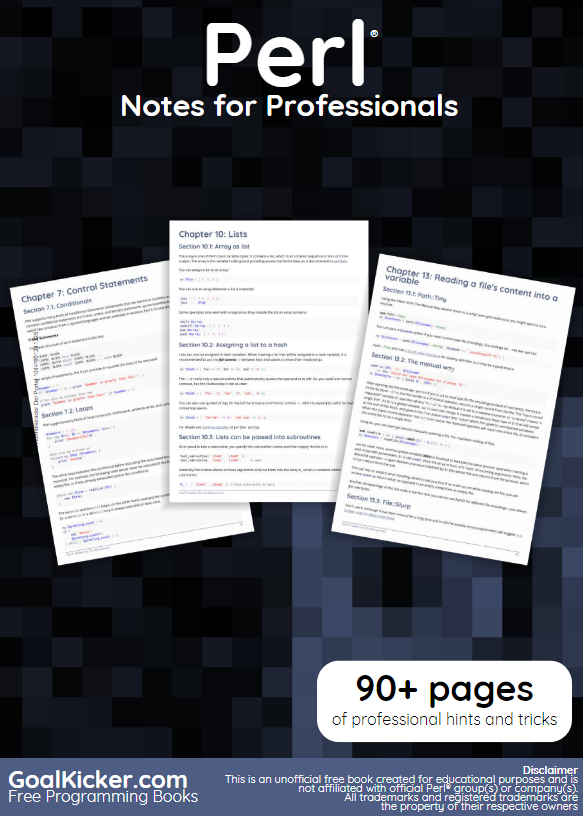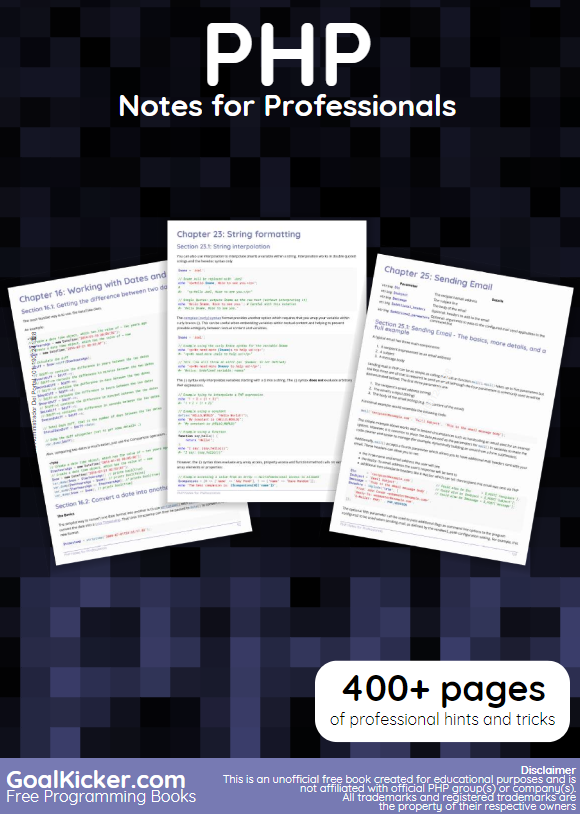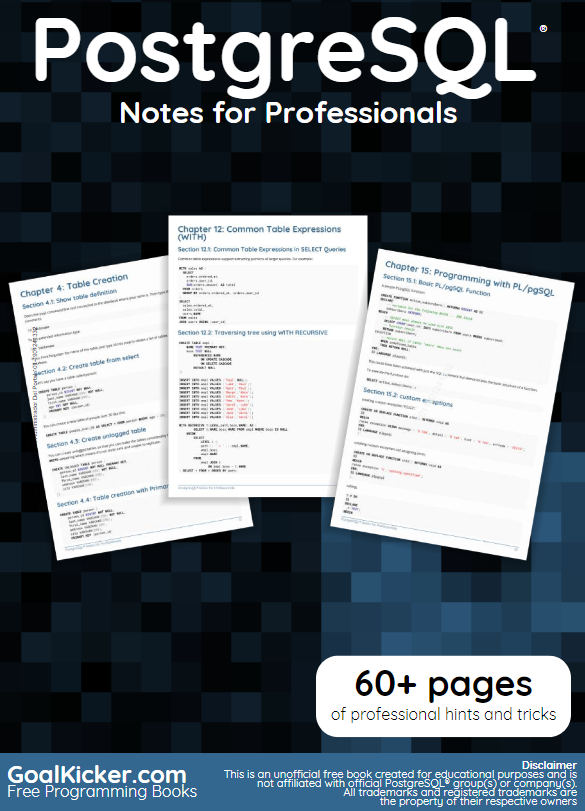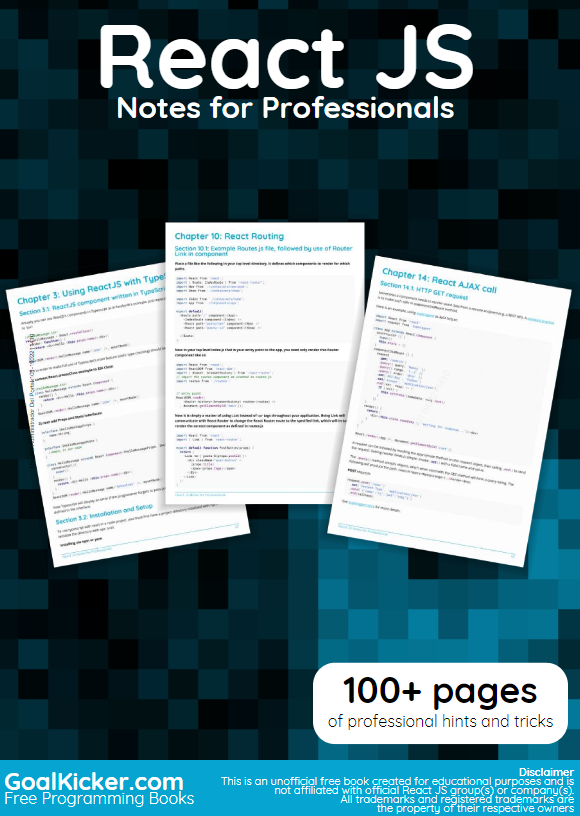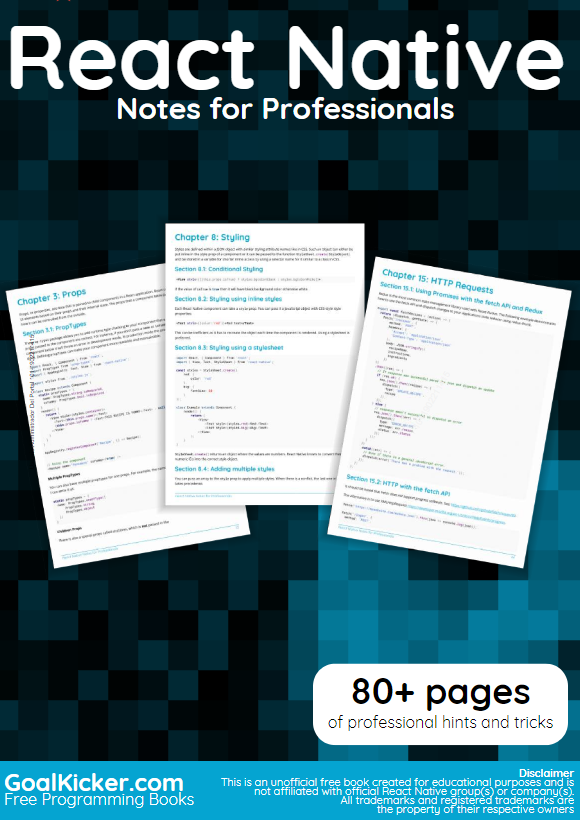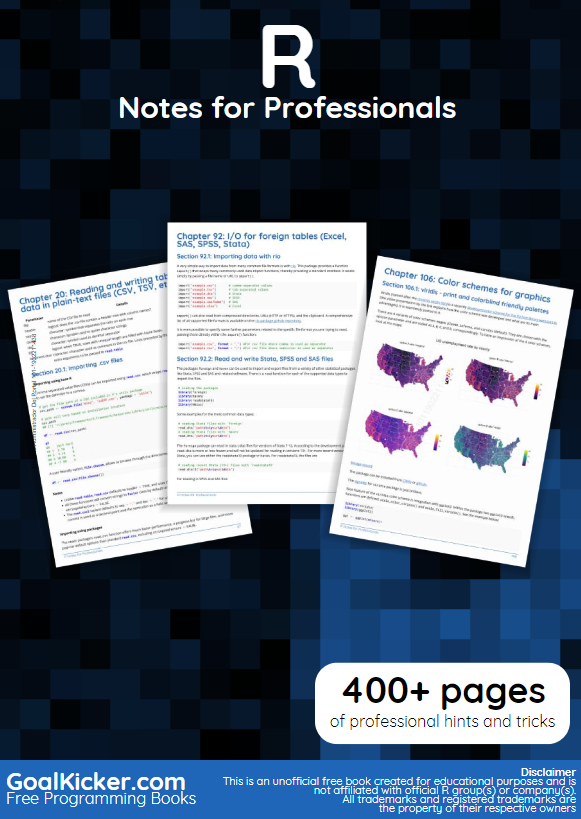
R
Notes for Professionals
Goalkicker.com Free Programming Books
Editorial: Otros
Edición: 1 (Gratuita)
Fecha Publicación: 2018
ISBN: -
ISBN ebook: -
Páginas: 475
Grado: Universitario
Área: Informática
Sección: Lenguajes y Metodología de la Programación
Idioma: Español
Etiquetas: Gratuito
 Tweet
Tweet
Edición: 1 (Gratuita)
Fecha Publicación: 2018
ISBN: -
ISBN ebook: -
Páginas: 475
Grado: Universitario
Área: Informática
Sección: Lenguajes y Metodología de la Programación
Idioma: Español
Etiquetas: Gratuito
 Tweet
Tweet
About
Chapter 1: Getting started with R Language
Chapter 2: Variables
Chapter 3: Arithmetic Operators
Chapter 4: Matrices
Chapter 5: Formula
Chapter 6: Reading and writing strings
Chapter 7: String manipulation with stringi package
Chapter 8: Classes
Chapter 9: Lists
Chapter 10: Hashmaps
Chapter 11: Creating vectors
Chapter 12: Date and Time
Chapter 13: The Date class
Chapter 14: Date-time classes (POSIXct and POSIXlt)
Chapter 15: The character class
Chapter 16: Numeric classes and storage modes
Chapter 17: The logical class
Chapter 18: Data frames
Chapter 19: Split function
Chapter 20: Reading and writing tabular data in plain-text files (CSV, TSV, etc.)
Chapter 21: Pipe operators (%>% and others)
Chapter 22: Linear Models (Regression)
Chapter 23: data.table
Chapter 24: Pivot and unpivot with data.table
Chapter 25: Bar Chart
Chapter 26: Base Plotting
Chapter 27: boxplot
Chapter 28: ggplot2
Chapter 29: Factors
Chapter 30: Pattern Matching and Replacement
Chapter 31: Run-length encoding
Chapter 32: Speeding up tough-to-vectorize code
Chapter 33: Introduction to Geographical Maps
Chapter 34: Set operations
Chapter 35: tidyverse
Chapter 36: Rcpp
Chapter 37: Random Numbers Generator
Chapter 38: Parallel processing
Chapter 39: Subsetting
Chapter 40: Debugging
Chapter 41: Installing packages
Chapter 42: Inspecting packages
Chapter 43: Creating packages with devtools
Chapter 44: Using pipe assignment in your own package %<>%: How to ?
Chapter 45: Arima Models
Chapter 46: Distribution Functions
Chapter 47: Shiny
Chapter 48: spatial analysis
Chapter 49: sqldf
Chapter 50: Code profiling
Chapter 51: Control flow structures
Chapter 52: Column wise operation
Chapter 53: JSON
Chapter 54: RODBC
Chapter 55: lubridate
Chapter 56: Time Series and Forecasting
Chapter 57: strsplit function
Chapter 58: Web scraping and parsing
Chapter 59: Generalized linear models
Chapter 60: Reshaping data between long and wide forms
Chapter 61: RMarkdown and knitr presentation
Chapter 62: Scope of variables
Chapter 63: Performing a Permutation Test
Chapter 64: xgboost
Chapter 65: R code vectorization best practices
Chapter 66: Missing values
Chapter 67: Hierarchical Linear Modeling
Chapter 68: *apply family of functions (functionals)
Chapter 69: Text mining
Chapter 70: ANOVA
Chapter 71: Raster and Image Analysis
Chapter 72: Survival analysis
Chapter 73: Fault-tolerant/resilient code
Chapter 74: Reproducible R
Chapter 75: Fourier Series and Transformations
Chapter 76: .Rprofile
Chapter 77: dplyr
Chapter 78: caret
Chapter 79: Extracting and Listing Files in Compressed Archives
Chapter 80: Probability Distributions with R
Chapter 81: R in LaTeX with knitr
Chapter 82: Web Crawling in R
Chapter 83: Creating reports with RMarkdown
Chapter 84: GPU-accelerated computing
Chapter 85: heatmap and heatmap.2
Chapter 86: Network analysis with the igraph package
Chapter 87: Functional programming
Chapter 88: Get user input
Chapter 89: Spark API (SparkR)
Chapter 90: Meta: Documentation Guidelines
Chapter 91: Input and output
Chapter 92: I/O for foreign tables (Excel, SAS, SPSS, Stata)
Chapter 93: I/O for database tables
Chapter 94: I/O for geographic data (shapefiles, etc.)
Chapter 95: I/O for raster images
Chapter 96: I/O for Rs binary format
Chapter 97: Recycling
Chapter 98: Expression: parse + eval
Chapter 99: Regular Expression Syntax in R
Chapter 100: Regular Expressions (regex)
Chapter 101: Combinatorics
Chapter 102: Solving ODEs in R
Chapter 103: Feature Selection in R -- Removing Extraneous Features
Chapter 104: Bibliography in RMD
Chapter 105: Writing functions in R
Chapter 106: Color schemes for graphics
Chapter 107: Hierarchical clustering with hclust
Chapter 108: Random Forest Algorithm
Chapter 109: RESTful R Services
Chapter 110: Machine learning
Chapter 111: Using texreg to export models in a paper-ready way
Chapter 112: Publishing
Chapter 113: Implement State Machine Pattern using S4 Class
Chapter 114: Reshape using tidyr
Chapter 115: Modifying strings by substitution
Chapter 116: Non-standard evaluation and standard evaluation
Chapter 117: Randomization
Chapter 118: Object-Oriented Programming in R
Chapter 119: Coercion
Chapter 120: Standardize analyses by writing standalone R scripts
Chapter 121: Analyze tweets with R
Chapter 122: Natural language processing
Chapter 123: R Markdown Notebooks (from RStudio)
Chapter 124: Aggregating data frames
Chapter 125: Data acquisition
Chapter 126: R memento by examples
Chapter 127: Updating R version
Credits
You may also like
*La edición digital no incluye códigos de acceso a material adicional o programas mencionados en el libro.


